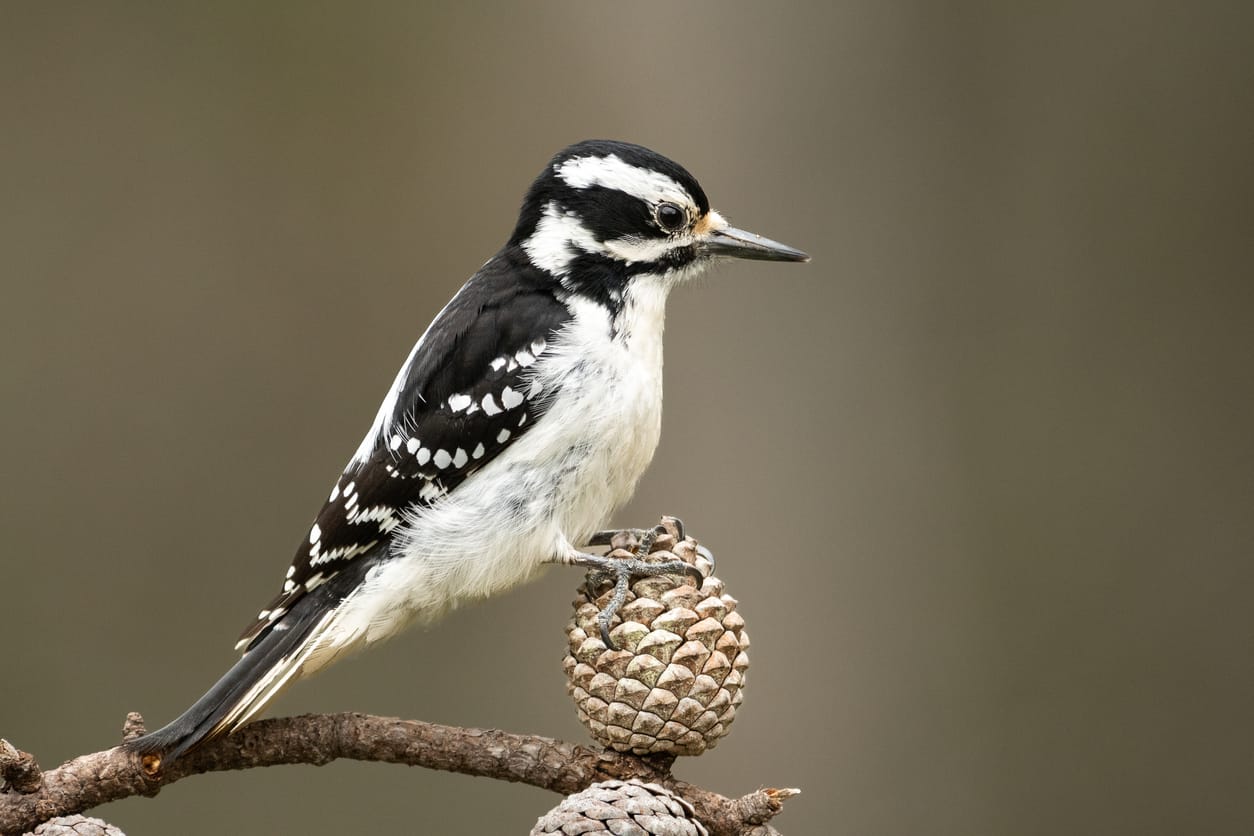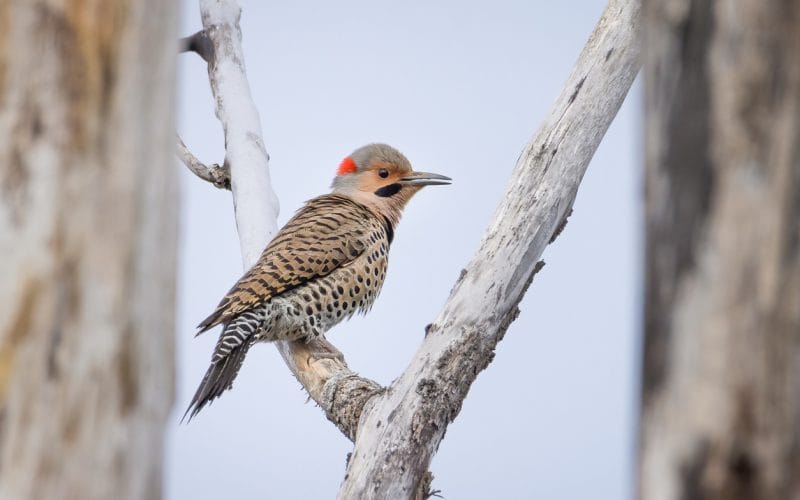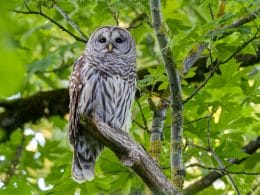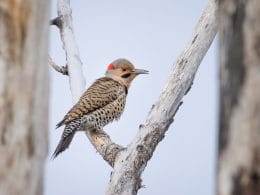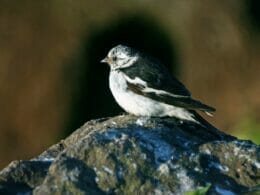Exploring Indiana can be tons of fun. There are so many creatures you can find in the Indiana woodlands. If what you’re looking for are woodpeckers in Indiana, you should have no trouble finding them. Let’s take a look at some of the woodpecker species in Indiana.
1. Hairy Woodpecker

- Scientific name: Leuconotopicus villosus
- Length: 7.1 to 10.2 inches
- Weight: 1.4 to 3.4 ounces
- Wingspan: 13 to 16.1 inches
- Average life span: 12 to 15 years
- Status: Least concern
The Hairy Woodpecker is one of the most common birds in Indiana. If you know where to look, you can find them all year round. They like to fly around and nest around woodlands.
When you see a Hairy Woodpecker, the first thing you notice is its black and white feathers. Their wings are black with white spots all over, with a white belly. They also have striped heads and a patch of white that goes all the way down the bird’s back.
Author Note: Most Hairy Woodpeckers look the same. However, there’s a difference in appearance between males and females. They are both the same size, but males have a flash of red feathers on their heads.
A Hairy Woodpeckers diet consists mostly of insects like ants and larvae. However, they’ll also eat larger insects like spiders and sometimes even millipedes.
Hairy Woodpeckers like to stay out of sight. That’s why they prefer to nest around the woodlands. There, they can find plenty of small spaces to build a shelter.
These woodpeckers prefer to carve out the inside of a dead tree to build their nests. Once they do find a tree and hollow it out, Hairy Woodpeckers can lay 3-6 eggs per season.
If you’re trying to spot a Hairy Woodpecker, it’s a good idea to start in a densely forested area. Still, sometimes if you’re lucky, you can find them in parks or woodlots. You can find them perched on large trunks or tree branches.
2. Downy Woodpecker

- Scientific name: Dryobates pubescens
- Length: 5.5 to 6.7 inches
- Weight: 0.7 to 1.0 ounces
- Wingspan: 9.8 to 11.8 inches
- Average life span: 1 to 2 years
- Status: Least concern
The Downy Woodpecker is fairly easy to spot in Indiana. They’re there all year round and don’t shy away from humans.
It looks incredibly similar to the Hairy Woodpecker. They are both black and white and the males have a flash of red on their heads. However, the major difference between the two woodpecker species is their size.
The Downy Woodpecker is much smaller. It’s only about a third of the size of a Hairy Woodpecker. That also makes it the smallest woodpecker on our list.
Since the Downy and Hairy Woodpecker look similar, it can be hard to tell the difference between them. However, they don’t spend their time in the same areas.
A Downy Woodpecker likes to fly around backyards and bird feeders. That’s why it’s much more likely for you to spot one. They also have a distinct whinny call that’s hard to miss.
Even though the Downy Woodpecker loves bird feeders, they also like to hunt for insects like larvae and nuts. Sometimes, you may even spot them drinking from hummingbird feeders.
When it comes to nesting, the Downy Woodpecker prefers dead trees. They hollow out the tree and build small nests that can house 3-8 eggs.
If you’re looking for a Downy Woodpecker nest, look for tall trees. They like to hide away from the line of sight to avoid predators.
3. Pileated Woodpecker

- Scientific name: Dryocopus pileatus
- Length: 15.8 to 19.3 inches
- Weight: 8.8 to 12.3 ounces
- Wingspan: 25 to 30 inches
- Average life span: 10 to 12 years
- Status: Least concern
A large leap from our tiniest Woodpecker, we have the Pileated Woodpecker. This is the largest species of woodpeckers in Indiana. That makes it much easier to spot them out in the wild.
You can find a Pileated Woodpecker any time of the year in Indiana. All you have to do is go looking in the woodlands.
The Pileated Woodpecker also has a black and white color palette. However, they’re mainly black. Their whole body is solid black with a single stripe of white going down either side. These stripes meet at the face.
Just like the Downy and Hairy Woodpeckers, the Pileated Woodpecker has red on its head. Still, the Pileated Woodpecker has a much bigger tuft of red. It looks like a giant triangular flame coming off its head.
Males and females of this species look pretty much identical. The only exception is that males have an extra red stripe on their cheeks.
The Pileated Woodpecker likes to eat a variety of food. Most of their diet consists of insects like carpenter ants. However, you can also find them eating nuts and fruits. These woodpeckers love blackberries and sumac berries. They can even eat the leaves of a dogwood.
Top Tip: When looking for Pileated Woodpeckers, keep your ears alert for a shrill call. It’s not an unpleasant shrill, but it’s definitely unique. They can also drum when they’re in flocks.
To find them, you can start by looking for an area with many dead trees. This makes the ideal habitat for a Pileated Woodpecker.
4. Red-Bellied Woodpecker
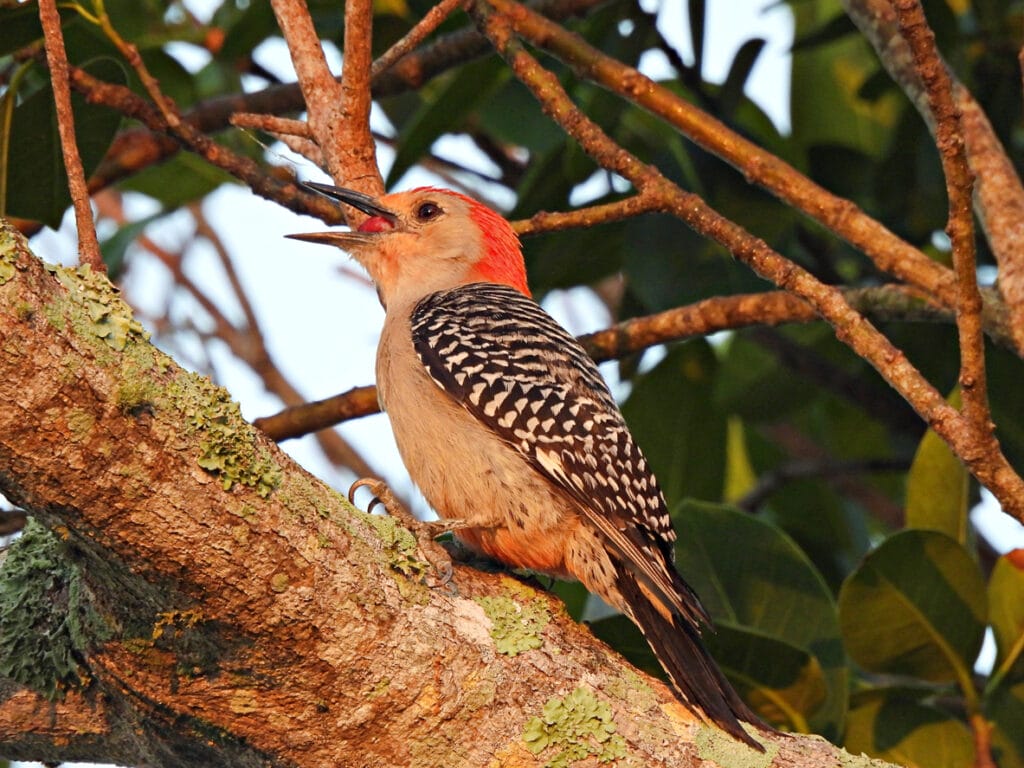
- Scientific name: Melanerpes carolinus
- Length: 9.1 to 10.6 inches
- Weight: 2.0 to 3.2 ounces
- Wingspan: 14.9 to 18.1 inches
- Average life span: 10 to 12 years
- Status: Least concern
These woodpeckers are a little rarer than the others on our list. While you can spot them throughout the year, it’s not likely. However, in Indiana, you might get lucky and see them during the winter.
This woodpecker is about the same size as the Hairy Woodpecker, but they look different. This woodpecker has a black and white barred pattern on its wings and back. The rest of their body is a light-gray color.
Just like their name suggests, the woodpecker has a red bell. Both males and females have a red patch of feathers directly between their legs. However, males also have a red cap on their heads and beaks.
Even though the belly is a bright red, it can be difficult to spot. You have to remember that woodpeckers are small creatures, so it may be hard to see a tiny red spot from a distance away. It’s best to keep an eye out for their barred patterns.
Just like the Downy Woodpecker, you can often see a Red-bellied Woodpecker at a birdfeeder. Still, they’re a lot shyer and fly away if you try to approach them too quickly. They also tend to visit at night when everyone is sleeping.
However, if you’re staying up at night trying to see a Red-bellied, listen out for a rolling call. It’s quite loud, so it should be easy to spot.
If you don’t have any luck with bird feeders, you can try searching the woodlands.
5. Red-Headed Woodpecker

- Scientific name: Melanerpes erythrocephalus
- Length: 7.5 to 9.1 inches
- Weight: 2.0 to 3.4 ounces
- Wingspan: 14 to 17 inches
- Average life span: 9 to 12 years
- Status: Near threatened
As you’ve probably already guessed, these birds get their name from the color of their heads. The Red-headed Woodpecker has bright red feathers all over its head. This makes it one of the most striking and noticeable woodpeckers on the list.
These birds like to nest in northern Indiana, but you can find them all year in the rest of the state. They especially like to fly around during the summer.
Many people confuse the Red-headed and Red-bellied Woodpeckers. However, the Red-headed Woodpecker is fully red from the neck up, while the Red-bellied Woodpecker only has a small red cap on the top of its head.
The Red-headed Woodpecker is one of the more feisty species of woodpeckers. They will defend their nests and territories and can get violent. It could even go as far as destroying the eggs and nests of other birds.
Aside from being aggressive, these birds are also excellent hunters. A Red-headed Woodpecker can catch an insect mid-flight. They like to hunt beetles, grasshoppers, and honeybees.
However, insects make up only about a third of this woodpecker’s diet. The Red-headed Woodpecker mainly eats seeds and berries.
Author Note: Unfortunately, Red-headed Woodpeckers’ numbers are slowly dwindling. Destruction of their habitats has decreased the number of these peckers flying around. This makes it a little more difficult to spot them out in the wild.
Still, if you’re dead set on seeing one, try looking around swamps and farms.
6. Yellow-bellied Sapsucker
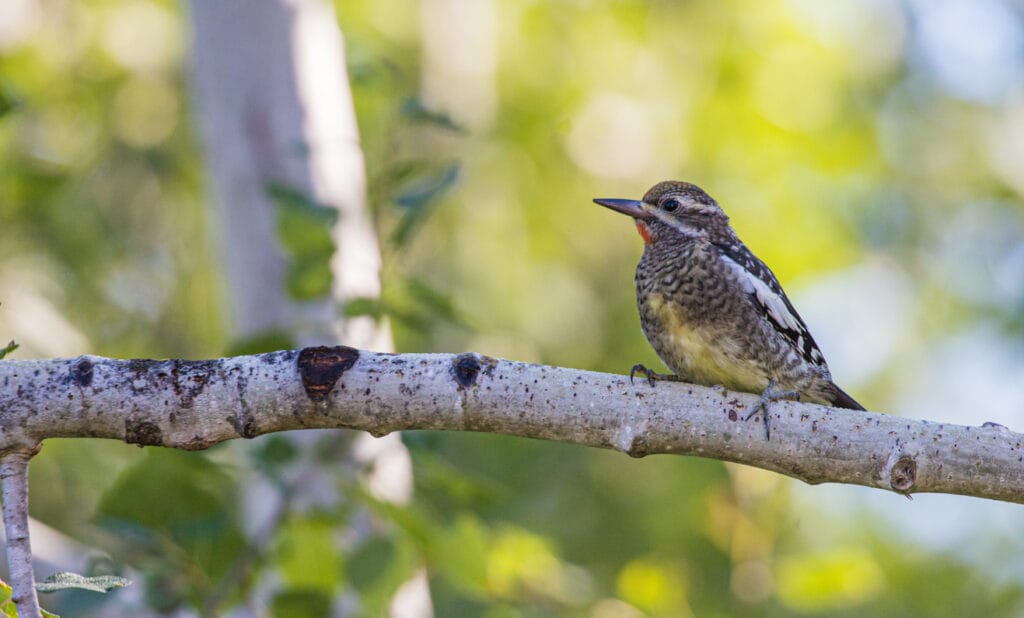
- Scientific name: Sphyrapicus varius
- Length: 7.1 to 8.7 inches
- Weight: 1.5 to 1.9 ounces
- Wingspan: 13.4 to 15.8 inches
- Average life span: 5 to 8 years
- Status: Least concern
Even though the Yellow-bellied Sapsucker is a migratory bird, you can still see it in Indiana. They’re especially active around the spring and fall.
The Yellow-bellied Sapsucker is mostly black with white spots all over. They also have a red patch on the very top of their heads. Males, however, also have a red patch right under their necks.
These are all characteristics we can find in other woodpeckers. Still, the Yellow-bellied Sapsucker is distinct. This is because of—you guessed it—its yellow belly. They have a small patch of yellow feathers in their mid-section.
This is another small bird that likes to hide. So, spotting it might prove challenging. The Yellow-bellied Sapsucker mainly likes to hang out around trees. That’s why they spend most of their time in small forests with birch and maple trees.
From the name you can guess that these birds like sap. Yellow-bellied Sapsuckers will find a tree and start making holes. Then, they use their tongues to get to the sap inside the tree.
You can spot a tree that a Yellow-bellied Sapsucker visited. All you have to do is keep an eye out for rows of tiny holes. These birds will peck holes in a horizontal line to make getting out the sap easier.
Yellow-bellied Sapsuckers like birch and sugar maple trees. The sap from these trees makes up the majority of their diet.
7. Northern Flicker

- Scientific name: Colaptes auratus
- Length: 11.0 to 12.2 inches
- Weight: 3.9 to 5.6 ounces
- Wingspan: 16.5 to 20.1 inches
- Average life span: 6 to 9 years
- Status: Least concern
The Northern Flicker is another common bird in Indiana. You can find these peckers at any time during the year. Sometimes you can see them in the sky, or on the ground looking for ants.
These peckers don’t resemble any other species on the list. They have a grayish-white feather coat with black spots. Another unique feature of this bird is the flash of yellow in its wings. You can’t see the yellow when the wings are moving, but they’re there.
Northern Flickers also have a very distinct call. It sounds like a loud shrieking. They use that call to communicate and locate each other in dense forests.
Most woodpeckers like to dig a hole into a tree to make a nest. However, Northern Flickers prefer to find pre-existing tree cavities. Even though they’re fairly small, they like plenty of space to make nests.
Top Tip: The trees are also an excellent hunting ground for these peckers. They usually pick trees that house other insects like ants and beetles. Moreover, if the trees have fruits, they’ll eat those too.
This makes it a little trickier to spot a Northern Flicker. They spend most of their time in and around their nest. So, to see one, you’ll have to go into the woodlands and look for one.
Wrapping Up
If you’re in Indiana and want to see some woodpeckers, you’re in luck. There are seven different woodpecker species in Indiana.
This means that no matter what time of year you visit, you’ll get to see a woodpecker. So, make sure you have your camera ready so you can document the moment.
FAQ
Have a look at some of these places:
Indiana Dunes State Park, Muscatatuck National Wildlife Refuge, Pokagon State Park to see Red-headed Woodpecker, Pileated Woodpecker.
The Hairy Woodpecker and the Northern Flicker are the most common woodpeckers in Indiana.
To find out where recent sightings of woodpecker have been, try eBird. You can search for the latest sightings or particular species or what has been seen in a certain area.




